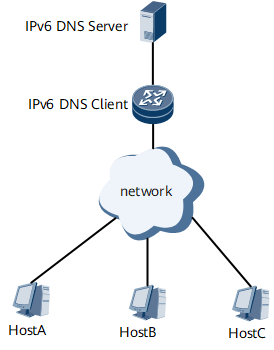Configuring IPv6 DNS Client
IPv6 DNS establishes mapping between domain names and IPv6 addresses, which allows devices to use domain names to communicate.
Usage Scenario
- If you seldom use domain names to access other devices or no IPv6 DNS server is available, configure static IPv6 DNS on the IPv6 DNS client. To configure static IPv6 DNS, you must know the mapping between domain names and IPv6 addresses. If a mapping changes, you must manually modify the IPv6 DNS entry on the IPv6 DNS client.
- If you want to use domain names to access many devices and IPv6 DNS servers are available, configure dynamic IPv6 DNS on the IPv6 DNS client.
Pre-configuration Tasks
Configure a route from an IPv6 DNS client to an IPv6 DNS server to allow the client and server to communicate at Layer 3.
Configure an IPv6 DNS server.
Procedure
- Configure static IPv6 DNS.
Run system-view
The system view is displayed.
Run ipv6 host host-name ipv6-address [ vpn-instance vpn-name ]
A static IPv6 DNS entry is configured.
Run commit
The configuration is committed.
- Configure dynamic IPv6 DNS.
Run system-view
The system view is displayed.
Run dns resolve
Dynamic DNS is enabled.
Run dns server ipv6 ipv6-address [ interface-type interface-number ] [ vpn-instance vpn-name ]
A DNS server is configured.
(Optional) Run dns server ipv6 source-ip [ vpn-instance vpn-name ] ipv6Addr
A source IPv6 address is specified for the IPv6 DNS client for domain name resolution.
Specifying a source IPv6 address to be used by an IPv6 DNS client to communicate with an IPv6 DNS server ensures communication security.
- Run dns domain domain-name [ vpn-instance vpn-name ]
A domain name suffix is added.
(Optional) Run dns timeout interval-time
A DNS query response timeout period is configured.
(Optional) Run dns try times
The number of retransmission times for DNS query packets is configured.
- Run commit
The configuration is committed.

To specify multiple DNS server IPv6 addresses, repeat Step 3. To specify multiple domain name suffixes, repeat Step 5.
Verifying the Configuration of IPv6 DNS
After configuring IPv6 DNS, verify the configuration.
Run the display ipv6 host command to check static IPv6 DNS entries that record mapping between host names and IPv6 addresses.
Run the display dns server command to check all DNS server IPv6 addresses.
Run the display dns domain command to check domain name suffixes.
Run the display dns ipv6 dynamic-host command to check dynamic IPv6 DNS entries in the domain name cache.
